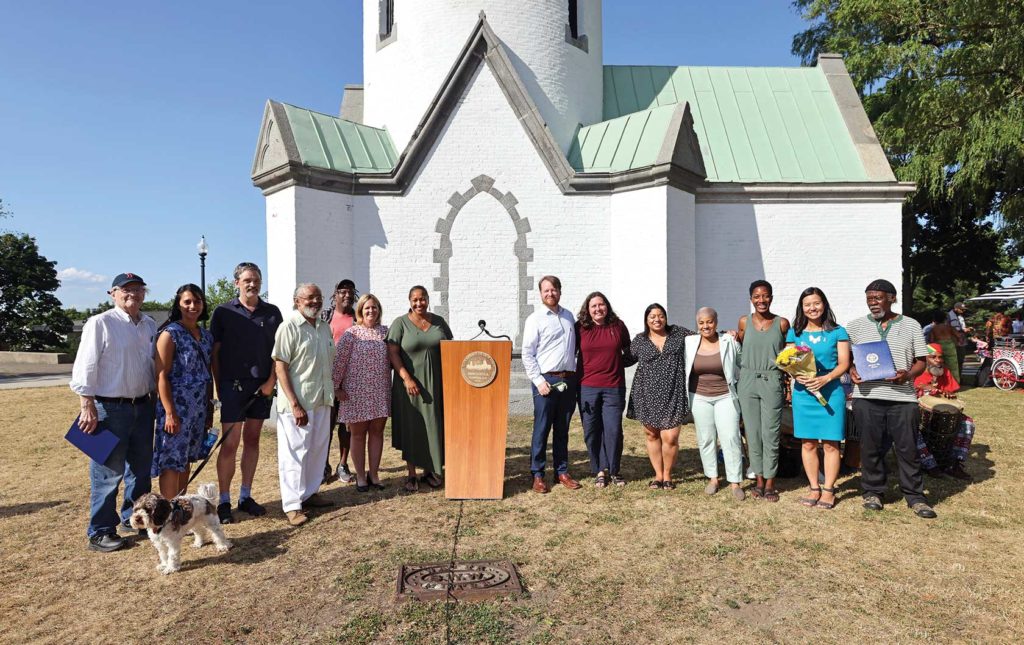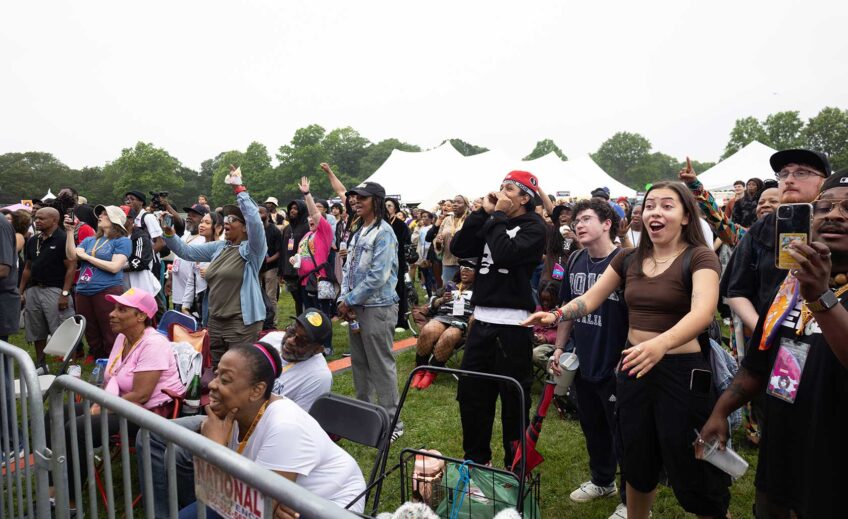Highland Park gets historic designation
Status places controls on demolitions, development in Roxbury neighborhood

In 1978, Highland Park residents submitted a petition to the Boston Landmarks Commission to secure a designation for the Roxbury neighborhood as a historical district. It’s taken 44 years, but on June 19, the mayor and the Boston City Council approved the designation, which gives neighbors and the Landmarks Commission the power to approve or reject real estate development projects in the area, bounded roughly by Malcolm X Boulevard, Washington Street, Columbus Avenue and Marcella Street.
“Where we’re standing now has seen major moments in this country’s history,” said Mayor Michelle Wu, speaking at the site of the Revolutionary War-era Roxbury High Fort, now the site of the Cochituate Standpipe, the white tower that once served as a water storage tank for the neighborhood. “I’m so grateful to the community leaders who have been rallying for decades to get us to this point where we can ensure that historic preservation is in line with community stability and affordability.”
The neighborhood includes a hodgepodge of architectural styles, including 18th-century Colonial buildings, early- and mid-century Greek revival, gothic revival, Queen Anne Victorians and contemporary homes, reflecting historical phases from its agrarian past to its current status as a mixed-income community facing the pressures of an overheated real estate market.
“To me, what’s interesting about this neighborhood is that it’s got 400 years of history that you see all around us,” said Kathy Kottaridis, executive director of Historic Boston Incorporated, a nonprofit that has renovated many of the historic buildings in the neighborhood. “You’ve got every style of architecture. There are so many layers that, together, express Roxbury’s history over time.”
The recent push for the historic district designation came as the neighborhood is facing pressure from for-profit developers who have been building on vacant parcels in the area. The luxury condominiums proliferating in the formerly working-class neighborhood have put pressure on long-term residents and led to increasing displacement, noted Highland Park Neighborhood Association member Rodney Singleton, who served on the study group that drafted the historical designation.
Singleton, who lives in a block of architecturally significant marble-facade homes on Cedar Street, noted that when he sought to repair his roof in 2006, the historical designation on his block mandated that the repairs be historically accurate, a requirement that put the work almost beyond his means.
Unlike the historical districts in the South End and Beacon Hill, Highland Park’s historical designation will not require homeowners to make repairs with historically accurate materials, such as slate roofs or wooden window sashes, which can add tens of thousands of dollars to repair work.
“We have folks who have lived here forever and can’t afford to take on those expenses,” Singleton said. “The study group was very sensitive to that. We’re not going to force people to have copper gutters.”
A critical difference between the Highland Park district and the South End is how the neighborhood’s residents view the area’s history. In the South End, which was built out on landfill in the mid-to-late 1800s, residents encoded the area’s Victorian-era history in their designation — a decision that in some ways ignored the 100 years of history during which the neighborhood was an enclave of working-class African Americans, Jews, Syrians, Italians and Irish.
Study group member Andrew Shelburne said neighborhood residents sought instead to draw on Highland Park’s centuries worth of history.
“We stripped it down to the basic things we wanted to protect — historic buildings, healthy trees, puddingstone outcrops, urban wilds, community gardens,” he said.
“This is not about real estate, it’s about community,” said Jon Ellertson, who attended the community meetings on a historical designation in 1978.
Ellertson noted that community members have over the years sought historical protection for individual buildings, such as the former home of filmmaker Henry Hampton on Lambert Avenue and the former St. James African Orthodox Church on Cedar Street. In both cases, the uses of the buildings neighbors sought to preserve were not directly related to the original use of the building.
The neighborhood will use the preservation status, he said, to protect not only the historical nature of the buildings, but also to preserve the mixed-income nature of the enclave in which he has lived since the early 1970s.
“We have a broader understanding of what historical preservation means,” Ellertson said. “Preservation is not just bricks and mortar. I love the buildings. But more than that, I love my neighbors.”







